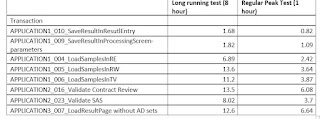I was debugging another interesting issue where after doing
a specific business transaction, Application pool getting stopped and service
become unavailable.
Application logs doesn’t give much details
2021-10-08
19:48:25.8085 4.10.191 INFO Beginning Startup...
2021-10-08
19:48:25.8505 4.10.191 INFO CORS configuration found, allowing the following
Origins:
2021-10-08
19:48:25.8505 4.10.191 INFO Allowed Origin: https://xxx.hostname..local
2021-10-08
19:48:25.8505 4.10.191 INFO Applying CORS Configurations
2021-10-08
19:48:25.8505 4.10.191 WARN `Auth Configuration not found, defaulting to IWA
2021-10-08
19:48:25.8505 4.10.191 INFO Configuring for Intergrated Windows Authentication
2021-10-08
19:48:28.0246 4.10.191 INFO Authorization.Extension: Start parsing :
"D:\inetpub\wwwroot \1.0\bin\Authorization.rules".
2021-10-08
19:48:28.1396 4.10.191 INFO Authorization Role Definitions have been created.
2021-10-08
19:48:28.1396 4.10.191 INFO Authorization.Extension: Successfully finished parsing
: "D:\inetpub\wwwroot\1.0\bin\Authorization.rules".
2021-10-08
19:48:31.2079 4.10.191 INFO Startup Completed.
Another Http exception was also observed as below
Message: Request is not available in this context
Stack:
[HelperMethodFrame]
System.Web.HttpContext.get_Request()
System.Web.HttpContextWrapper.get_Request()
NLog.Web.Internal.HttpContextExtensions.TryGetRequest(System.Web.HttpContextBase)
NLog.Web.LayoutRenderers.AspNetRequestValueLayoutRenderer.DoAppend(System.Text.StringBuilder, NLog.LogEventInfo)
NLog.LayoutRenderers.LayoutRenderer.RenderAppendBuilder(NLog.LogEventInfo, System.Text.StringBuilder)
NLog.Layouts.SimpleLayout.RenderAllRenderers(NLog.LogEventInfo, System.Text.StringBuilder)
NLog.Layouts.Layout.RenderAppendBuilder(NLog.LogEventInfo, System.Text.StringBuilder, Boolean)
NLog.Layouts.SimpleLayout.PrecalculateBuilder(NLog.LogEventInfo, System.Text.StringBuilder)
NLog.Targets.Target.PrecalculateVolatileLayoutsConcurrent(NLog.LogEventInfo)
NLog.Targets.Wrappers.AsyncTargetWrapper.Write(NLog.Common.AsyncLogEventInfo)
NLog.Targets.Wrappers.AsyncTargetWrapper.WriteAsyncThreadSafe(NLog.Common.AsyncLogEventInfo)
NLog.Targets.Target.WriteAsyncLogEvent(NLog.Common.AsyncLogEventInfo)
NLog.LoggerImpl.WriteToTargetWithFilterChain(NLog.Targets.Target, NLog.Filters.FilterResult, NLog.LogEventInfo, NLog.Common.AsyncContinuation)
NLog.LoggerImpl.Write(System.Type, NLog.Internal.TargetWithFilterChain, NLog.LogEventInfo, NLog.LogFactory)
NLog.Logger.Trace(System.String)
System.Web.HttpApplication.InitModulesCommon()
System.Web.HttpApplication.InitInternal(System.Web.HttpContext, System.Web.HttpApplicationState, System.Reflection.MethodInfo[])
System.Web.HttpApplicationFactory.GetNormalApplicationInstance(System.Web.HttpContext)
System.Web.HttpRuntime.ProcessRequestNotificationPrivate(System.Web.Hosting.IIS7WorkerRequest, System.Web.HttpContext)
System.Web.Hosting.PipelineRuntime.ProcessRequestNotificationHelper(IntPtr, IntPtr, IntPtr, Int32)
System.Web.Hosting.PipelineRuntime.ProcessRequestNotification(IntPtr, IntPtr, IntPtr, Int32)
DomainNeutralILStubClass.IL_STUB_ReversePInvoke(Int64, Int64, Int64, Int32)
Events logs
Events logs has below entries and it doesn’t have stack
trace to debug
- A process serving application pool name.Psh'
suffered a fatal communication error with the Windows Process Activation
Service. The process id was '53196'. The data field contains the error number.
- Application pool name.Psh ' is being
automatically disabled due to a series of failures in the process(es) serving
that application pool.
- Application popup: w3wp.exe - System Error : A
new guard page for the stack cannot be created.
To debug, I have configured debugdiag to capture memory
dumps on crash and found couple of exceptions on the threads
45 60
1ef18 00000214ce10fff0 1029220
Preemptive
0000000000000000:0000000000000000 00000214af874010 0 Ukn (Threadpool Worker)
46 62
7884 00000214cdf937a0 1029220
Cooperative 00000214B811CB00:00000214B811D8D0 00000214af95f900 0 Ukn (Threadpool Worker)
47 47
8b50 00000214ce0f28c0 8029220
Preemptive
0000000000000000:0000000000000000 00000214af874010 0 Ukn (Threadpool Completion Port)
48 65
17114 00000214ce10a1f0 8029220
Preemptive
0000000000000000:0000000000000000 00000214af874010 0 Ukn (Threadpool Completion Port)
49 63
7bd4 00000214cdbafd90 1029220
Preemptive
0000000000000000:0000000000000000 00000214af874010 0 Ukn (Threadpool Worker)
50 61
1598 00000214ce0ab520 1029220
Preemptive
0000000000000000:0000000000000000 00000214af874010 0 Ukn (Threadpool Worker)
51 58
16c04 00000214ce0f20f0 1029220
Preemptive
0000000000000000:0000000000000000 00000214af874010 0 Ukn (Threadpool Worker)
52 57
1314c 00000214cdfaf0e0 1029220
Preemptive
0000000000000000:0000000000000000 00000214af874010 0 Ukn (Threadpool Worker)
53 55
1ecfc 00000214cdfad060 1029220
Preemptive
0000000000000000:0000000000000000 00000214af874010 0 Ukn (Threadpool Worker)
54 54
12004 00000214ce10c130 1029220
Preemptive
0000000000000000:0000000000000000 00000214af874010 0 Ukn (Threadpool Worker)
55 53 128f0
00000214ce0f3860 1029220 Preemptive 00000214B811A580:00000214B811B8D0
00000214af95f900 0 Ukn (Threadpool
Worker) System.Web.HttpException 00000214b811a498
56 52
c7a0 00000214ce0fa0d0 1029220
Preemptive
00000214B80E8168:00000214B80E98D0 00000214af95f900 1 Ukn (Threadpool Worker) System.StackOverflowException
00000214afc91158
57 48 e110 00000214ce0c0950 1029220 Preemptive 0000000000000000:0000000000000000
00000214af874010 0 Ukn (Threadpool
Worker)
58 34
7a4c 00000214ce0f0980 1029220
Preemptive
0000000000000000:0000000000000000 00000214af874010 0 Ukn (Threadpool Worker)
59 39
3450 00000214ce0f1150 1029220
Preemptive
0000000000000000:0000000000000000 00000214af874010 0 Ukn (Threadpool Worker)
from the dump, Its clear that app pool crashed due to System.StackOverflowException
on thread 56
Review the stack trace of thread 56 gives hint that
automapper causing stack overflow
RootCause
Application has circular reference in its classes which are
used on the workflow because of this when user attempt to perform type casting
via automapper, stack is getting filled up.
Solution to the problem is to Avoid type conversion via auto
mapper instead converting types using manual mapping.





















